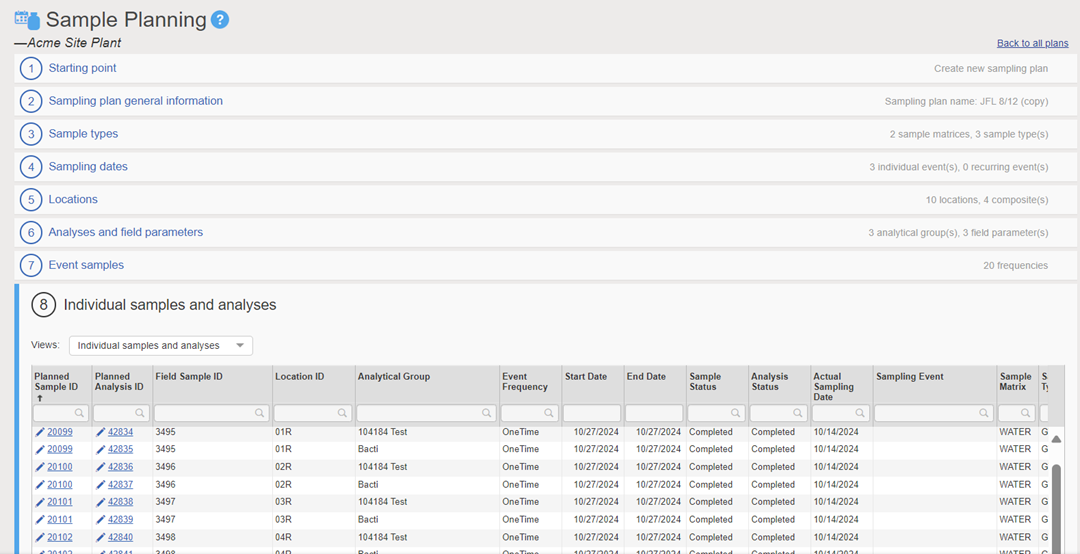EIM Top Enhancements and Features in 2024
Let’s look back on the most exciting new features added to the EIM application during 2024!
1. Improved Sample Planning Module
Locus released the new and improved Sample Planning Module this summer which includes:
- A visually pleasing vertical interface that streamlines the sampling planning workflow.
- User friendly messaging to minimize mismatched information (water matrix samples with soil analyses) and assignment of QC samples.
- Flexible scheduling of single or recurring events based on common sampling frequencies.
- Enhanced requested analysis tracking and added tools for managing and editing planned sampling events.
- Addition of percent complete for samples and analyses in the sampling plan overview grid.


2. Multisite Query options
If you manage environmental data for multiple sites and projects, you can benefit from looking at data across your entire portfolio. For example, you may want to view every recent benzene exceedance in all your projects, or you may want to see which sites are showing increasing trends in lead concentrations in water samples.
Locus understands the importance of these ‘multisite’ queries and added multisite query options to EIM in 2024. The following modules now allow users to query across sites:
- GIS+
- Intermediate Custom Queries
- Expert Custom Queries
- Quick Views
- Analytical Views
- Exceedances

Example of multisite query filter.
3. Intermediate Custom Query improvements
The Intermediate Custom Query module lets users build queries using a graphical interface for selecting output fields and data filters. In 2024, Locus improved this module by adding these features:
- Saved Queries
- Users can share saved queries and make them private/public.
- Users can save both fields and filters for future use (before, only fields could be saved).
- Users can pin saved queries to the Project Manager (PM) Console.
- Improved Interface
- The query interface is simpler and has a defined linear flow.
- The form for selecting tables guides the user to prevent inconsistent or incorrect queries.
- Users can access and run a saved query without opening the query for editing.
- Enhanced Queries
- Queries support filtering by site (current site, all sites, or multiple selected sites).

Table selection options for Intermediate Custom Queries.
4. EIM API improvements
Locus provides an API (application programming interface) for EIM that is accessed by calling a URL. The EIM API returns data from a user-defined EIM Expert Query. To use the API, the user calls the API with the query to run and relevant Locus login credentials. The EIM API then returns data in JSON or OData format, which are standard text-based data formats understood by many business intelligence applications.
In 2024, Locus improved the EIM API by:
- Making significant performance improvements to support large query outputs.
- Adding support for JWT (JavaScript Web Token) authentication, which is required for some applications that use API output.
- A user can generate a secret key within their EIM profile.
- They can then pass that secret key to an API call to get a time-limited access token.
- This access token can then be used in the API call to get the expert query results.
5. SSO Login for Mobile
The iOS Locus Mobile app now includes an SSO login feature. This feature displays EIM’s and Locus Platform’s existing SSO login web forms. Once successfully logged in via the SSO IDP, app server interactions should behave normally as expected.
For Locus Platform, this feature includes selecting a tenant if the user is assigned to multiple mobile-enabled tenants. If the user only has a single mobile-enabled tenant assigned, then that tenant is automatically selected without any select widget displayed.
Locus is the only self-funded water, air, soil, biological, energy, and waste EHS software company that is still owned and managed by its founder. The brightest minds in environmental science, embodied carbon, CO2 emissions, refrigerants, and PFAS hang their hats at Locus, and they’ve helped us to become a market leader in EHS software. Every client-facing employee at Locus has an advanced degree in science or professional EHS experience, and they incubate new ideas every day – such as how machine learning, AI, blockchain, and the Internet of Things will up the ante for EHS software, ESG, and sustainability.



